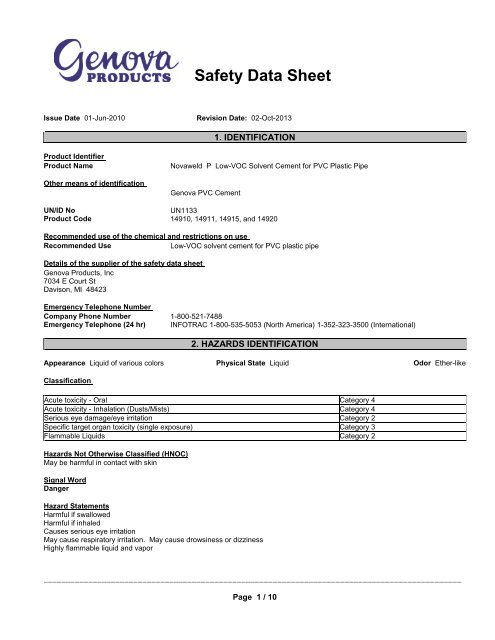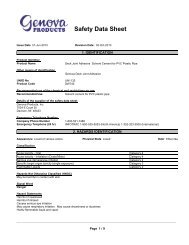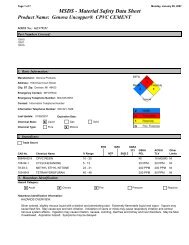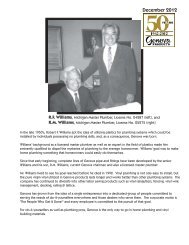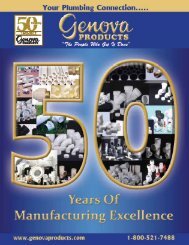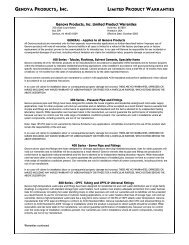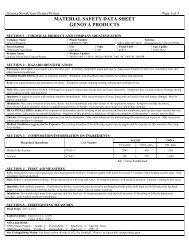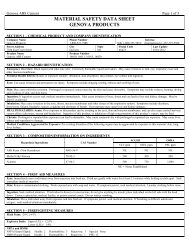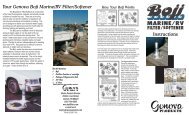NovaWeld⢠P Cement - Genova Products
NovaWeld⢠P Cement - Genova Products
NovaWeld⢠P Cement - Genova Products
Create successful ePaper yourself
Turn your PDF publications into a flip-book with our unique Google optimized e-Paper software.
Safety Data Sheet<br />
Issue Date 01-Jun-2010<br />
Revision Date: 02-Oct-2013<br />
1. IDENTIFICATION<br />
Product Identifier<br />
Product Name<br />
Other means of identification<br />
Novaweld P Low-VOC Solvent <strong>Cement</strong> for PVC Plastic Pipe<br />
<strong>Genova</strong> PVC <strong>Cement</strong><br />
UN/ID No<br />
UN1133<br />
Product Code 14910, 14911, 14915, and 14920<br />
Recommended use of the chemical and restrictions on use<br />
Recommended Use<br />
Low-VOC solvent cement for PVC plastic pipe<br />
Details of the supplier of the safety data sheet<br />
<strong>Genova</strong> <strong>Products</strong>, Inc<br />
7034 E Court St<br />
Davison, MI 48423<br />
Emergency Telephone Number<br />
Company Phone Number 1-800-521-7488<br />
Emergency Telephone (24 hr) INFOTRAC 1-800-535-5053 (North America) 1-352-323-3500 (International)<br />
2. HAZARDS IDENTIFICATION<br />
Appearance Liquid of various colors Physical State Liquid Odor Ether-like<br />
Classification<br />
Acute toxicity - Oral Category 4<br />
Acute toxicity - Inhalation (Dusts/Mists) Category 4<br />
Serious eye damage/eye irritation Category 2<br />
Specific target organ toxicity (single exposure) Category 3<br />
Flammable Liquids Category 2<br />
Hazards Not Otherwise Classified (HNOC)<br />
May be harmful in contact with skin<br />
Signal Word<br />
Danger<br />
Hazard Statements<br />
Harmful if swallowed<br />
Harmful if inhaled<br />
Causes serious eye irritation<br />
May cause respiratory irritation. May cause drowsiness or dizziness<br />
Highly flammable liquid and vapor<br />
_____________________________________________________________________________________________<br />
Page 1 / 10
ARROW 1104MB Low-VOC PVC <strong>Cement</strong><br />
Revision Date: 02-Oct-2013<br />
_____________________________________________________________________________________________<br />
Precautionary Statements - Prevention<br />
Use personal protective equipment as required<br />
Wash face, hands and any exposed skin thoroughly after handling<br />
Do not eat, drink or smoke when using this product<br />
Avoid breathing dust/fume/gas/mist/vapors/spray<br />
Use only outdoors or in a well-ventilated area<br />
Keep away from heat/sparks/open flames/hot surfaces. — No smoking<br />
Keep container tightly closed<br />
Ground/bond container and receiving equipment<br />
Use explosion-proof equipment<br />
Use only non-sparking tools<br />
Take precautionary measures against static discharge<br />
Wear protective gloves/protective clothing/eye protection/face protection<br />
Keep cool<br />
Precautionary Statements - Response<br />
If exposed or concerned: Get medical advice/attention<br />
IF IN EYES: Rinse cautiously with water for several minutes. Remove contact lenses, if present and easy to do. Continue rinsing<br />
Immediately call a POISON CENTER or doctor/physician<br />
IF ON SKIN (or hair): Remove/Take off immediately all contaminated clothing. Rinse skin with water/shower<br />
IF INHALED: Remove victim to fresh air and keep at rest in a position comfortable for breathing<br />
IF SWALLOWED: Call a POISON CENTER or doctor/physician if you feel unwell<br />
Rinse mouth<br />
IN CASE OF FIRE: Use CO2, dry chemical, or foam for extinction<br />
Precautionary Statements - Storage<br />
Store in a well-ventilated place. Keep container tightly closed<br />
Store locked up<br />
Keep cool<br />
Precautionary Statements - Disposal<br />
Dispose of contents/container to an approved waste disposal plant<br />
WHMIS Classification<br />
Class B-Division 2 Class D-Division 2A Class D-Division 2B<br />
3. COMPOSITION/INFORMATION ON INGREDIENTS<br />
Chemical Name CAS No Weight-%<br />
Tetrahydrofuran 109-99-9 Proprietary<br />
Methyl ethyl ketone 78-93-3 Proprietary<br />
Cyclohexanone 108-94-1 Proprietary<br />
Acetone 67-64-1 Proprietary<br />
PVC Resin 9002-86-2 Proprietary<br />
* The exact percentage (concentration) of composition has been withheld as a trade secret<br />
_____________________________________________________________________________________________<br />
Page 2 / 10
ARROW 1104MB Low-VOC PVC <strong>Cement</strong><br />
Revision Date: 02-Oct-2013<br />
_____________________________________________________________________________________________<br />
First Aid Measures<br />
4. FIRST-AID MEASURES<br />
General Advice<br />
Eye Contact<br />
Skin Contact<br />
Inhalation<br />
Ingestion<br />
If exposed or concerned: Get medical advice/attention.<br />
In case of irritation from airborne exposure, move to fresh air. Rinse immediately with plenty<br />
of water, also under the eyelids, for at least 15 minutes. Seek immediate medical<br />
attention/advice.<br />
Take off contaminated clothing. Wash with soap and water. If symptoms persist, call a<br />
physician. Wash contaminated clothing before reuse.<br />
Remove to fresh air. If symptoms persist, call a physician. If breathing is difficult, give<br />
oxygen. Seek immediate medical attention/advice.<br />
Rinse mouth. Seek medical attention. If drowsy or unconscious, do not give anything by<br />
mouth; place individual on the left side with head down. Do not induce vomiting.<br />
Most important symptoms and effects<br />
Symptoms<br />
Exposed individuals may experience eye tearing, redness and discomfort. Prolonged or<br />
repeated skin contact may result in dermatitis (red, dry skin). May cause nose and throat<br />
irritation, with possible central nervous system effects. Fatigue and weakness. May cause<br />
drowsiness or dizziness. Long term overexposure may cause liver and kidney damage.<br />
Indication of any immediate medical attention and special treatment needed<br />
Notes to Physician<br />
Treat symptomatically. Individuals with chronic respiratory, skin, kidney, or liver disorders<br />
may be at increased risk from exposure.<br />
5. FIRE-FIGHTING MEASURES<br />
Suitable Extinguishing Media<br />
Foam. Carbon dioxide (CO2). Dry chemical.<br />
Unsuitable Extinguishing Media Not determined.<br />
Specific Hazards Arising from the Chemical<br />
Class IB Flammable Liquid. Vapors may travel to source of ignition and flash back.<br />
Hazardous Combustion <strong>Products</strong> Carbon oxides. Various hydrocarbon vapors and toxic gases.<br />
Protective equipment and precautions for firefighters<br />
As in any fire, wear self-contained breathing apparatus pressure-demand, MSHA/NIOSH (approved or equivalent) and full<br />
protective gear.<br />
6. ACCIDENTAL RELEASE MEASURES<br />
Personal precautions, protective equipment and emergency procedures<br />
Personal Precautions<br />
Environmental Precautions<br />
Use personal protective equipment as required. ELIMINATE all ignition sources (no<br />
smoking, flares, sparks or flames in immediate area). Persons not wearing proper personal<br />
protective equipment should be excluded from area of spill.<br />
Do not allow into any sewer, on the ground or into any body of water.<br />
Methods and material for containment and cleaning up<br />
_____________________________________________________________________________________________<br />
Page 3 / 10
ARROW 1104MB Low-VOC PVC <strong>Cement</strong><br />
Revision Date: 02-Oct-2013<br />
_____________________________________________________________________________________________<br />
Methods for Containment Prevent further leakage or spillage if safe to do so.<br />
Methods for Clean-Up<br />
Pump or vacuum transfer spilled product to clean containers for recovery. Absorb<br />
unrecoverable product. Transfer contaminated absorbent, soil and other materials to<br />
containers for disposal.<br />
7. HANDLING AND STORAGE<br />
Precautions for safe handling<br />
Advice on Safe Handling<br />
Wash thoroughly after handling. Use personal protection recommended in Section 8. Do<br />
not eat, drink or smoke when using this product. Avoid breathing vapors or mists. Use only<br />
in well-ventilated areas. Ground/bond container and receiving equipment. Keep away from<br />
heat/sparks/open flames/hot surfaces. — No smoking. Use spark-proof tools and explosionproof<br />
equipment. Take precautionary measures against static discharges. Containers of this<br />
material may be hazardous when emptied. Since emptied containers retain product<br />
residues (vapor, liquid, solid) all hazard precautions given in the data sheet must be<br />
observed. Avoid prolonged contact with eyes, skin, and clothing. Obtain special instructions<br />
before use. Do not handle until all safety precautions have been read and understood.<br />
Conditions for safe storage, including any incompatibilities<br />
Storage Conditions<br />
Incompatible Materials<br />
Keep containers tightly closed in a dry, cool and well-ventilated place. Store containers<br />
upright. Store away from heat, sparks, flame.<br />
Oxidizers. Acids. Bases.<br />
8. EXPOSURE CONTROLS/PERSONAL PROTECTION<br />
Exposure Guidelines<br />
Chemical Name ACGIH TLV OSHA PEL NIOSH IDLH<br />
Tetrahydrofuran<br />
109-99-9<br />
Acetone<br />
67-64-1<br />
Methyl ethyl ketone<br />
78-93-3<br />
Cyclohexanone<br />
108-94-1<br />
PVC Resin<br />
9002-86-2<br />
STEL: 100 ppm<br />
TWA: 50 ppm<br />
S*<br />
STEL: 750 ppm<br />
TWA: 500 ppm<br />
STEL: 300 ppm<br />
TWA: 200 ppm<br />
STEL: 50 ppm<br />
TWA: 20 ppm<br />
S*<br />
TWA: 200 ppm<br />
TWA: 590 mg/m 3<br />
(vacated) TWA: 200 ppm<br />
(vacated) TWA: 590 mg/m 3<br />
(vacated) STEL: 250 ppm<br />
(vacated) STEL: 735 mg/m 3<br />
TWA: 1000 ppm<br />
TWA: 2400 mg/m 3<br />
(vacated) TWA: 750 ppm<br />
(vacated) TWA: 1800 mg/m 3<br />
(vacated) STEL: 2400 mg/m 3<br />
The acetone STEL does not apply<br />
to the cellulose acetate fiber<br />
industry. It is in effect for all other<br />
sectors<br />
(vacated) STEL: 1000 ppm<br />
TWA: 200 ppm<br />
TWA: 590 mg/m 3<br />
(vacated) TWA: 200 ppm<br />
(vacated) TWA: 590 mg/m 3<br />
(vacated) STEL: 300 ppm<br />
(vacated) STEL: 885 mg/m 3<br />
TWA: 50 ppm<br />
TWA: 200 mg/m 3<br />
(vacated) TWA: 25 ppm<br />
(vacated) TWA: 100 mg/m 3<br />
(vacated) S*<br />
IDLH: 2000 ppm<br />
TWA: 200 ppm<br />
TWA: 590 mg/m 3<br />
STEL: 250 ppm<br />
STEL: 735 mg/m 3<br />
IDLH: 2500 ppm<br />
TWA: 250 ppm<br />
TWA: 590 mg/m 3<br />
IDLH: 3000 ppm<br />
TWA: 200 ppm<br />
TWA: 590 mg/m 3<br />
STEL: 300 ppm<br />
STEL: 885 mg/m 3<br />
IDLH: 700 ppm<br />
TWA: 25 ppm<br />
TWA: 100 mg/m 3<br />
TWA: 1 mg/m 3 respirable fraction - -<br />
_____________________________________________________________________________________________<br />
Page 4 / 10
ARROW 1104MB Low-VOC PVC <strong>Cement</strong><br />
Revision Date: 02-Oct-2013<br />
_____________________________________________________________________________________________<br />
Appropriate engineering controls<br />
Engineering Controls<br />
Apply technical measures to comply with the occupational exposure limits. Ventilation<br />
systems. Eyewash stations. Showers. Mechanical exhaust (explosion proof) may be<br />
required.<br />
Individual protection measures, such as personal protective equipment<br />
Eye/Face Protection<br />
Skin and Body Protection<br />
Respiratory Protection<br />
Splash goggles or safety glasses.<br />
Rubber gloves. Use body protection appropriate for task.<br />
Not required under normal conditions. If recommended levels are exceeded, respiratory<br />
protection must be selected to assure compliance with OSHA Standard 29CFR 1910.134.<br />
General Hygiene Considerations Handle in accordance with good industrial hygiene and safety practice.<br />
Information on basic physical and chemical properties<br />
9. PHYSICAL AND CHEMICAL PROPERTIES<br />
Physical State<br />
Liquid<br />
Appearance Liquid of various colors Odor Ether-like<br />
Color Clear Gray White Odor Threshold 0.88 ppm<br />
Property Values Remarks • Method<br />
pH<br />
Not available<br />
Melting Point/Freezing Point -108 °C / -163 °F<br />
Boiling Point/Boiling Range 56 °C / 133 °F<br />
Flash Point -20 °C / -4 °F<br />
Evaporation Rate > 1.0 (butyl acetate = 1)<br />
Flammability (Solid, Gas)<br />
n/a-liquid<br />
Upper Flammability Limits 12.8%<br />
Lower Flammability Limit 1.8%<br />
Vapour Pressure 190 mm Hg @ 20°C (68°F)<br />
Vapor Density 2.5 (Air=1)<br />
Specific Gravity 0.910<br />
Water Solubility<br />
Negligible<br />
Solubility in other solvents Not determined<br />
Partition Coefficient<br />
Not determined<br />
Auto-ignition Temperature 321 °C / 610 °F Not determined<br />
Decomposition Temperature Not determined<br />
Kinematic Viscosity<br />
Not determined<br />
Dynamic Viscosity<br />
Not determined<br />
Explosive Properties<br />
Not determined<br />
Oxidizing Properties<br />
Not determined<br />
VOC Content<br />
Maximum VOC emissions when applied and tested per SCAQMD Rule 1168, Test Method<br />
316A is
ARROW 1104MB Low-VOC PVC <strong>Cement</strong><br />
Revision Date: 02-Oct-2013<br />
_____________________________________________________________________________________________<br />
Hazardous Polymerization Hazardous polymerization does not occur.<br />
Conditions to Avoid<br />
Avoid heat, sparks, open flames and other ignition sources.<br />
Incompatible Materials<br />
Oxidizers. Acids. Bases.<br />
Hazardous Decomposition <strong>Products</strong><br />
Carbon oxides. Hydrogen chloride. Other various hydrocarbons.<br />
Information on likely routes of exposure<br />
Product Information<br />
11. TOXICOLOGICAL INFORMATION<br />
Eye Contact<br />
Skin Contact<br />
Inhalation<br />
Ingestion<br />
Causes serious eye irritation.<br />
May be harmful in contact with skin.<br />
Harmful if inhaled.<br />
Harmful if swallowed.<br />
Component Information<br />
Chemical Name Oral LD50 Dermal LD50 Inhalation LC50<br />
Tetrahydrofuran<br />
109-99-9<br />
= 1650 mg/kg ( Rat ) - = 53.9 mg/L ( Rat ) 4 h = 180 mg/L<br />
( Rat ) 1 h<br />
Acetone<br />
= 5800 mg/kg ( Rat ) - -<br />
67-64-1<br />
Methyl ethyl ketone<br />
= 2737 mg/kg ( Rat ) = 6480 mg/kg ( Rabbit ) -<br />
78-93-3<br />
Cyclohexanone<br />
108-94-1<br />
= 800 mg/kg ( Rat ) = 948 mg/kg ( Rabbit ) = 10.7 mg/L ( Rat ) 4 h = 8000 ppm<br />
( Rat ) 4 h<br />
Information on physical, chemical and toxicological effects<br />
Symptoms<br />
Please see section 4 of this SDS for symptoms.<br />
Delayed and immediate effects as well as chronic effects from short and long-term exposure<br />
Carcinogenicity<br />
The table below indicates whether each agency has listed any ingredient as a carcinogen.<br />
However, the product as a whole has not been tested.<br />
Chemical Name ACGIH IARC NTP OSHA<br />
Tetrahydrofuran<br />
A3<br />
109-99-9<br />
Cyclohexanone<br />
A3 Group 3<br />
108-94-1<br />
PVC Resin<br />
Group 3<br />
9002-86-2<br />
Legend<br />
ACGIH (American Conference of Governmental Industrial Hygienists)<br />
A3 - Animal Carcinogen<br />
IARC (International Agency for Research on Cancer)<br />
Group 3 IARC components are "not classifiable as human carcinogens"<br />
STOT - single exposure<br />
May cause respiratory irritation. May cause drowsiness or dizziness.<br />
_____________________________________________________________________________________________<br />
Page 6 / 10
ARROW 1104MB Low-VOC PVC <strong>Cement</strong><br />
Revision Date: 02-Oct-2013<br />
_____________________________________________________________________________________________<br />
Numerical measures of toxicity<br />
Not determined<br />
Ecotoxicity<br />
Category IV<br />
12. ECOLOGICAL INFORMATION<br />
Chemical Name Algae/aquatic plants Fish Toxicity to<br />
microorganisms<br />
Tetrahydrofuran<br />
1970 - 2360: 96 h<br />
109-99-9<br />
Pimephales promelas mg/L<br />
LC50 flow-through 2700 -<br />
3600: 96 h Pimephales<br />
promelas mg/L LC50 static<br />
Acetone<br />
67-64-1<br />
Methyl ethyl ketone<br />
78-93-3<br />
Cyclohexanone<br />
108-94-1<br />
Persistence/Degradability<br />
Not determined.<br />
Bioaccumulation<br />
Not determined.<br />
Mobility<br />
20: 96 h Chlorella vulgaris<br />
mg/L EC50<br />
4.74 - 6.33: 96 h<br />
Oncorhynchus mykiss mL/L<br />
LC50 6210 - 8120: 96 h<br />
Pimephales promelas mg/L<br />
LC50 static 8300: 96 h<br />
Lepomis macrochirus mg/L<br />
LC50<br />
3130 - 3320: 96 h<br />
Pimephales promelas mg/L<br />
LC50 flow-through<br />
481 - 578: 96 h Pimephales<br />
promelas mg/L LC50 flowthrough<br />
8.9: 96 h<br />
Pimephales promelas mg/L<br />
LC50<br />
Crustacea<br />
5930: 24 h Daphnia magna<br />
mg/L EC50<br />
EC50 = 14500 mg/L 15 min 10294 - 17704: 48 h Daphnia<br />
magna mg/L EC50 Static<br />
12600 - 12700: 48 h Daphnia<br />
magna mg/L EC50<br />
EC50 = 3403 mg/L 30 min<br />
EC50 = 3426 mg/L 5 min<br />
EC50 = 18.5 mg/L 5 min<br />
EC50 = 21.3 mg/L 10 min<br />
EC50 = 25 mg/L 5 min<br />
520: 48 h Daphnia magna<br />
mg/L EC50 5091: 48 h<br />
Daphnia magna mg/L EC50<br />
4025 - 6440: 48 h Daphnia<br />
magna mg/L EC50 Static<br />
800: 24 h Daphnia magna<br />
mg/L EC50<br />
Chemical Name<br />
Tetrahydrofuran<br />
109-99-9<br />
Methyl ethyl ketone<br />
78-93-3<br />
Cyclohexanone<br />
108-94-1<br />
Acetone<br />
67-64-1<br />
Partition Coefficient<br />
0.45<br />
0.29<br />
0.86<br />
-0.24<br />
Other Adverse Effects<br />
Not determined<br />
13. DISPOSAL CONSIDERATIONS<br />
Waste Treatment Methods<br />
_____________________________________________________________________________________________<br />
Page 7 / 10
ARROW 1104MB Low-VOC PVC <strong>Cement</strong><br />
Revision Date: 02-Oct-2013<br />
_____________________________________________________________________________________________<br />
Disposal of Wastes<br />
Disposal should be in accordance with applicable regional, national and local laws and<br />
regulations.<br />
Contaminated Packaging<br />
Disposal should be in accordance with applicable regional, national and local laws and<br />
regulations.<br />
US EPA Waste Number<br />
Chemical Name RCRA RCRA - Basis for Listing RCRA - D Series Wastes RCRA - U Series Wastes<br />
Tetrahydrofuran<br />
U213<br />
109-99-9<br />
Acetone<br />
Included in waste stream:<br />
U002<br />
67-64-1<br />
F039<br />
Methyl ethyl ketone<br />
U159<br />
Included in waste streams: 200.0 mg/L regulatory level U159<br />
78-93-3<br />
F005, F039<br />
Cyclohexanone<br />
108-94-1<br />
Included in waste stream:<br />
F039<br />
U057<br />
California Hazardous Waste Status<br />
Chemical Name<br />
Tetrahydrofuran<br />
109-99-9<br />
Methyl ethyl ketone<br />
78-93-3<br />
Acetone<br />
67-64-1<br />
California Hazardous Waste Status<br />
Toxic<br />
Ignitable<br />
Toxic<br />
Ignitable<br />
Ignitable<br />
14. TRANSPORT INFORMATION<br />
Note<br />
Please see current shipping paper for most up to date shipping information, including<br />
exemptions and special circumstances. Shipments of containers holding 5 Liters or less per<br />
inner packaging may qualify for a "Limited Quantity" exception. Refer to 49 CFR 173.150<br />
for additional information.<br />
DOT<br />
UN/ID No<br />
UN1133<br />
Proper Shipping Name Adhesives<br />
Hazard Class 3<br />
Packing Group<br />
II<br />
IATA<br />
UN/ID No<br />
UN1133<br />
Proper Shipping Name Adhesives<br />
Hazard Class 3<br />
Packing Group<br />
II<br />
IMDG<br />
UN/ID No<br />
UN1133<br />
Proper Shipping Name Adhesives<br />
Hazard Class 3<br />
Packing Group<br />
II<br />
Marine Pollutant<br />
No<br />
_____________________________________________________________________________________________<br />
Page 8 / 10
ARROW 1104MB Low-VOC PVC <strong>Cement</strong><br />
Revision Date: 02-Oct-2013<br />
_____________________________________________________________________________________________<br />
International Inventories<br />
TSCA<br />
Listed<br />
Legend:<br />
TSCA - United States Toxic Substances Control Act Section 8(b) Inventory<br />
15. REGULATORY INFORMATION<br />
DSL/NDSL - Canadian Domestic Substances List/Non-Domestic Substances List<br />
EINECS/ELINCS - European Inventory of Existing Chemical Substances/European List of Notified Chemical Substances<br />
ENCS - Japan Existing and New Chemical Substances<br />
IECSC - China Inventory of Existing Chemical Substances<br />
KECL - Korean Existing and Evaluated Chemical Substances<br />
PICCS - Philippines Inventory of Chemicals and Chemical Substances<br />
US Federal Regulations<br />
CERCLA<br />
Chemical Name Hazardous Substances RQs CERCLA/SARA RQ Reportable Quantity (RQ)<br />
Tetrahydrofuran<br />
109-99-9<br />
1000 lb RQ 1000 lb final RQ<br />
RQ 454 kg final RQ<br />
Methyl ethyl ketone<br />
78-93-3<br />
5000 lb RQ 5000 lb final RQ<br />
RQ 2270 kg final RQ<br />
Cyclohexanone<br />
108-94-1<br />
5000 lb RQ 5000 lb final RQ<br />
RQ 2270 kg final RQ<br />
Acetone<br />
67-64-1<br />
5000 lb RQ 5000 lb final RQ<br />
RQ 2270 kg final RQ<br />
SARA 313<br />
Not determined<br />
US State Regulations<br />
California Proposition 65<br />
This product may contain trace levels of chemicals known to the State of California to cause cancer. Exposure to these chemicals<br />
above the State of California 'No Significant Risk Level' is unlikely under normal use conditions.<br />
U.S. State Right-to-Know Regulations<br />
Chemical Name New Jersey Massachusetts Pennsylvania<br />
Tetrahydrofuran<br />
X X X<br />
109-99-9<br />
Acetone<br />
X X X<br />
67-64-1<br />
Methyl ethyl ketone<br />
X X X<br />
78-93-3<br />
Cyclohexanone<br />
X X X<br />
108-94-1<br />
PVC Resin<br />
9002-86-2<br />
X<br />
_____________________________________________________________________________________________<br />
Page 9 / 10
ARROW 1104MB Low-VOC PVC <strong>Cement</strong><br />
Revision Date: 02-Oct-2013<br />
_____________________________________________________________________________________________<br />
16. OTHER INFORMATION<br />
NFPA<br />
HMIS<br />
Health Hazards<br />
2<br />
Health Hazards<br />
2<br />
Flammability<br />
3<br />
Flammability<br />
3<br />
Instability<br />
1<br />
Physical Hazards<br />
1<br />
Special Hazards<br />
None<br />
Personal Protection<br />
G<br />
Issue Date<br />
Revision Date:<br />
Revision Note<br />
01-Jun-2010<br />
02-Oct-2013<br />
New format<br />
Disclaimer<br />
The information provided in this Safety Data Sheet is correct to the best of our knowledge, information and belief at the<br />
date of its publication. The information given is designed only as a guidance for safe handling, use, processing, storage,<br />
transportation, disposal and release and is not to be considered a warranty or quality specification. The information<br />
relates only to the specific material designated and may not be valid for such material used in combination with any other<br />
materials or in any process, unless specified in the text.<br />
End of Safety Data Sheet<br />
_____________________________________________________________________________________________<br />
Page 10 / 10


